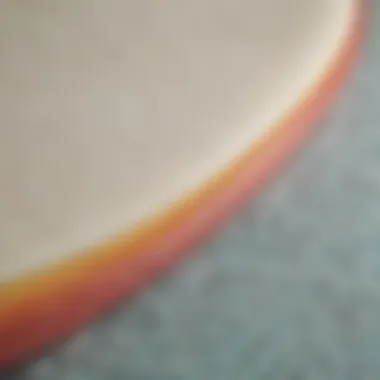Exploring Foam's Impact on Surfboarding Performance


Intro
Surfing is not just a sport; it's a dance with the waves, a culture built around the thrill of the ocean. Central to that experience is foam, the unsung hero of surfboards. Many surfers, from the rookie trying to catch their first wave to the seasoned pro carving flawless turns, might underestimate foam's pivotal role. This article dives into foam’s widespread applications in surfboard construction, its benefits for performance, and the innovations steering its evolution.
Foam is more than just padding; it influences speed, buoyancy, and maneuverability. The right foam can mean the difference between a mediocre session and an unforgettable ride. Environmentally mindful surfers are increasingly considering how foam types impact the ocean we all cherish. So, whether you’re a surfer or a curious onlooker, understanding the relationship between foam and surfboarding enriches your appreciation for the sport. Brace yourself as we explore the intricate world of foam in surfboards, examining both the science and artistry behind it.
Preface to Surfing Foam
Foam plays a crucial role in the world of surfboarding, serving as a fundamental component that shapes not only the board's performance but also the overall surfing experience. In this article, we explore its different materials, diverse benefits, and innovative techniques that enhance the surfboard design. Understanding the role of foam is essential for surfers of all levels, whether they're just dipping their toes into the waves or riding the gnarly swells with expert finesse.
Defining Surfing Foam
Surfing foam is primarily the material used to create the core of surfboards. Most commonly, it can be categorized into various types based on composition and physical properties. Polyurethane foam, for example, is widely used due to its light weight and resilience. Alternatively, expanded polystyrene foam provides buoyancy while being environmentally friendly.
When we talk about surfing foam, we're referring not just to its physical presence but also how its properties interact with the surfer's needs. Whether you're going for a slick and speedy ride or a more stable approach in choppy waters, the right foam can dramatically influence performance.
Historical Context
To truly appreciate the significance of foam in surfboards, it’s vital to look back at its historical evolution. Originally, surfboards were crafted from solid wood, which came with a hefty weight and limited maneuverability. The shift to foam began in the mid-20th century when surfers started to experiment with lighter materials that could mirror the fluidity of the ocean.
Early in the 1960s, design innovations led to the introduction of polyurethane foam. This not only made boards lighter but also provided a new level of floatation that transformed surfing techniques and styles. Over the years, with environmental concerns on the rise, there has been a movement towards using more sustainable foam alternatives. Therefore, today's surfboards are a byproduct of decades of experimentation and a commitment to improving surf performance while being mindful of ecological impact.
As we dive deeper into this article, we will unravel the types of foam used in surfboards, the benefits they offer, and how they impact both performance and the environment. Understanding these aspects gives surfers the insight needed to choose the right board tailored to their personal style and the specific conditions they encounter on the water.
Types of Foam Used in Surfboards
When it comes to surfboard design, the type of foam used plays a pivotal role in determining not just the feel of the board underfoot, but also its performance across different conditions. Each foam type offers unique characteristics that cater to various surfing styles and preferences. Understanding these materials is key for anyone looking to either enhance their surfing experience or get into the nitty-gritty of surfboard manufacturing.
Polyurethane Foam
Polyurethane foam has long been a staple in surfboard construction. This type of foam is commoly praised for its balance between flexibility and strength, making it an ideal choice for most surfers. What sets polyurethane foam apart is its ability to provide excellent buoyancy and a great feel for the wave. Because of its versatile nature, many shapers have opted for this material for a wide range of board types.
- Pros:
- Cons:
- Good durability
- Versatile in shaping
- Less eco-friendly compared to newer options
The lightweight yet sturdy construction of polyurethane foam allows surfers to maneuver quickly. You’ll find that many high-performance short boards are built with this material due to the crisp response it provides during turns. Finally, it can be repaired more easily than some of the other foam types, allowing a bit more peace of mind if accidents do happen on the water.
Expanded Polystyrene Foam
Expanded Polystyrene Foam, often abbreviated as EPS, is becoming increasingly popular in the surfboard market. One of its standout features is its lightweight nature, which allows for greater speed when slicing through the water. EPS is particularly beneficial for surfers looking for maximum speed and buoyancy, which is a must for those who enjoy more aggressive styles of riding.
- Pros:
- Cons:
- Lightweight
- Excellent buoyancy and speed
- Can be less durable than polyurethane
However, this comfort does come at a cost; EPS can sometimes be prone to dings and damage. Also, while it generally represents a step forward in buoyancy, riders may find that they lose a bit of that intimate feel with the waves compared to polyurethane. Yet, with appropriate shaping techniques and resin combinations, shapers continue to experiment and push the limits of what EPS can do.
EVA Foam
EVA foam, or ethylene-vinyl acetate foam, serves a different purpose in surfboard construction. While it’s not usually the main material for the board itself, you’ll often find EVA used for the grips and pads on the board. This foam is soft, flexible, and provides a comfortable surface for your feet, crucial during long surf sessions.
- Pros:
- Cons:


- Excellent cushioning
- Non-slip characteristics
- Less rigid
EVA foam helps to enhance grip, giving surfers confidence when they ride, especially during more challenging maneuvers or in choppy waters. This aspect is critical, as a strong connection to the board can significantly improve overall performance. Though it can’t compete with other foams concerning overall structural support, its role is undeniably integral to ensuring a more enjoyable ride.
"The type of foam you choose can turn a good ride into a great one—equipping you to take on the waves with confidence."
In summary, each type of foam brings its own flavor to the surfboard, altering the feel and performance capabilities. Understanding the nuances of polyurethanel, expanded polystyrene, and EVA foam can help surfers make informed decisions about what might work best for their unique style and needs.
Benefits of Foam in Surfboard Design
The significance of foam in surfboard design goes beyond mere aesthetics and functionality; it directly influences how surfers interact with the ocean. Foam serves several essential roles, including optimal buoyancy, enhanced durability, and the potential for customization. These benefits not only cater to the preferences of novice surfers but also meet the intricate demands of seasoned athletes. Understanding these advantages helps surfboard enthusiasts appreciate the technology and engineering behind each ride.
Weight Reduction
When it comes to surfboard performance, weight plays a crucial role. Generally, a lighter board allows for better maneuverability and quicker response times in the water. Foam materials typically used in surfboards are specifically designed to reduce overall weight without sacrificing strength. Polyurethane foam and expanded polystyrene foam are particularly effective at achieving this balance.
One might note the irony: a lot of water may weigh a ton, but the less we carry on a surfboard, the more agile we become on the waves. Removing just a few ounces on a board can translate to significant improvements in performance, making the surfer feel more connected to the ocean.
Floatation and Buoyancy
Floatation and buoyancy are not just technical terms tossed around at surf shows; they are fundamental to the surfing experience itself. A surfboard's buoyancy enables surfers to ride waves effectively and efficiently. Foam, being less dense than water, grants surfboards their floatation capabilities. This is vital for both paddling out to catch waves and for maintaining balance while riding them.
Surfers often use boards with high buoyancy in specific conditions, say when tackling smaller or softer waves. Boards that excel at floatation allow for gentler landings and more forgiving rides, particularly beneficial for less experienced surfers. The beauty of surfboard foam lies in its versatility; it caters to the varied preferences of surfers.
Durability and Repairability
Durability is another critical consideration when designing surfboards. A board that quickly succumbs to dings and dents is a surfer's nightmare. Foam has the unique ability to absorb shocks, thus extending the life of a surfboard. For instance, polyurethane foam retains its shape even after several hits against rocks or reefs, while EPS foam remains resilient due to its closed-cell structure.
Moreover, repairability is a substantial factor when discussing foam in surfboard designs. Most foam types allow for straightforward repairs, meaning that a knowledgeable surfer can typically fix minor damages themselves, thus prolonging the board's lifespan. This convenience is invaluable to surfers who prefer to keep their favorite boards in pristine condition.
The ability to fix a board quickly not only saves money but also fosters a deeper connection between surfers and their gear. In essence, the benefits derived from foam materials significantly elevate the surfing experience, where every ounce of floatation, every reduction of weight, and every bit of durability count.
"The right surfboard is like a second skin; it should feel like an extension of yourself as you ride the waves."
Foam Influence on Surfboard Performance
Foam plays a pivotal role in how surfboards perform on the water. It's not just about staying afloat; it's also about speed, responsiveness, and the overall feel of the ride. The right type of foam can enhance a surfer's experience, making it crucial for both the novice and the seasoned pro. The materials used can make a world of difference in how a board handles waves, turns, and maintains balance under various conditions. When you think about your surfing journey, the quality of foam can be a game-changer.
Speed and Maneuverability
Speed is the name of the game in surfing. When surfers talk about tracking down the perfect wave, they often overlook the crucial link between foam density and board hydrodynamics. Softer foams allow for an easily pliable board, facilitating agile maneuvers that are essential for performing sharp turns. But there's a balance; too soft might mean a sluggish response on bigger waves.
- Light and Fast: High-density foams paired with a slick finish boost speed and reduce drag, helping to slice through wave faces quickly.
- Tweak Your Ride: By customizing the foam's shape, surfers can influence the quickness and sharpness of turns, allowing for a more dynamic ride.
The marriage of foam and surfboard design is vital. A board with the right foam can feel like an extension of the surfer's body, offering the instinctive ability to switch gears in an instant.
Stability in Various Conditions
When you're out battling choppy waters or navigating powerful swells, stability becomes indispensable. The right foam contributes significantly to how stable a board feels regardless of the water type.
- Foam Core: Surfers often gravitate towards thicker foam cores for improved stability. This extra bulk provides a solid platform against rough conditions.
- Weight Distribution: Different foams can alter weight distribution. A well-placed heavier foam section can keep a board grounded while still allowing for flexibility in the nose and tail.
Altogether, a board's performance in various conditions hinges on foam type, letting surfers maintain control even when Mother Nature throws a curveball.
Customizability for Different Styles
Every surfer has their unique style, and the foam used to craft their board should reflect this individuality. Different foam types can be molded to align with specific performance characteristics, catering to diverse surfing styles.


- Tailored Shapes: Whether you’re into longboarding or shortboarding, different foam properties allow makers to design boards that match various maneuvers and preferences.
- Layering Techniques: Adjusting foam layers can finesse a board’s stiffness or flexibility, allowing surfers to fine-tune their ride.
Ultimately, customizing foam characteristics isn’t just about personal preference; it’s about enhancing performance. Having a board built to match your style means riding in harmony with the waves.
"The better the foam, the better the board—and ultimately, the better the ride. It's all intertwined in the surfing dance."
In the end, understanding foam influence on surfboard performance is essential for anyone looking to elevate their surfing game. Whether you’re chasing speed or seeking stabilization, foam plays a crucial role in your experience on the water.
Advanced Foam Techniques in Surfboard Manufacturing
The surfboard manufacturing landscape continually evolves, particularly through advanced foam techniques that revolutionize design and performance. The integration of these techniques not only enhances individualized surfing experiences but also addresses durability issues and environmental sustainability. Today, surfboard manufacturers adopt various innovative processes that capitalize on the properties of foam, creating boards tailored to different surfer preferences and conditions.
Foam Shaping Methods
Shaping foam is a foundational aspect of surfboard construction. There are several methods that artisans employ, each bringing out distinct characteristics in the board. One popular technique is the use of a CNC (Computer Numerical Control) machine. It enables precise shaping, allowing for intricate designs that would be difficult to replicate by hand. This method significantly reduces material waste, providing a cleaner and more efficient way of crafting surfboards.
Another traditional approach is hand shaping, where shapers utilize tools such as sanders and knives to carve foam blocks. While this method is more labor-intensive, it permits a level of artistry and customization often sought after by surfers who desire a unique board that echoes their personal style. Each method has its merits, and the choice largely hinges on the desired balance between precision and artistry.
Layering Techniques
Layering is another critical process in surfboard manufacturing that directly impacts performance and durability. By adjusting the type and number of layers, manufacturers can achieve different flex properties and strength levels in their boards. It’s all about striking the right balance.
Most surfboards utilize fiberglass as the primary external layer, but some manufacturers are experimenting with various materials to enhance eco-friendliness, like bio-based resins or natural fiber composites. These new-age layering techniques ensure reduced weight and increased strength without compromising the board's performance.
"Layering isn’t just about putting materials together; it’s about understanding how each component interacts to create the desired end product."
Careful consideration of layering also allows for the integration of various colors and patterns, making each board not just a tool for surfing, but a piece of art that reflects the surfer's personality.
Use of Composites
The use of composite materials in surfboard construction is gaining traction and is pivotal in enhancing performance. By combining different forms of foam with fiberglass or carbon fiber composites, manufacturers create boards that boast superior strength and low weight. This fusion of materials produces boards that can endure rigorous conditions while still maintaining agility and responsiveness.
Moreover, manufacturer-led innovations have led to repeated advancements in foam composites, which offer improved resistance to dings and water absorption. Some leading brands are even looking at fully recyclable composite options, contributing to the industry's push towards sustainability.
Focusing on the chemistry behind composites not only makes surfboards lighter but also addresses the environmental concerns associated with traditional foam materials. It’s a win-win for surfers and Mother Nature alike.
Advanced foam techniques represent a remarkable intersection of tradition and innovation, ensuring that every surfer, whether novice or pro, can find a board that meets their individual needs and preferences. As technology advances, these techniques will likely continue to evolve, shaping the future of surfboard manufacturing.
Environmental Considerations of Foam Use
The impact of foam on the surfing world is not simply about performance or durability; it also circles back to our responsibilities towards the environment. Over the years, the surf industry has faced increased scrutiny regarding the ecological footprint of the materials used in surfboards. In particular, foam, which serves as a core material in surfboard construction, brings forth a dialogue about sustainability and environmental integrity.
Understanding the environmental considerations of foam is crucial for surfers and manufacturers alike, as it guides the decisions we make regarding surfboard materials and their ultimate lifecycle. This section examines two key areas: the recyclability of foam materials and sustainable manufacturing practices that can mitigate harmful effects on the environment.
Recyclability of Foam Materials
The recyclability of foam materials is a pressing concern. Traditional foam types, such as polyurethane and expanded polystyrene, are notorious for their challenges in recycling. Due to their chemical compositions, many landfills are flooded with discarded surfboards and foam remnants that can take thousands of years to decompose. This accumulation isn’t just an eyesore—it contributes to global pollution, sometimes ending up in oceans, affecting marine life.
However, some innovations have emerged in recent years:
- Specialized Recycling Programs: Companies like Surfboards Direct or The Surfboard Recycling Company are helping to turn old surfboards into new products. Whether it's repurposing foam into padding for sports equipment or creating new surfboards from the recycled material, these initiatives are shifting the paradigm.
- Material Innovations: Recent developments in foam technology have led to the creation of biodegradable alternatives. Some newer brands are utilizing bio-based foams that can break down naturally. This approach not only reduces the environmental burden but also gives surfers an option to ride the waves guilt-free.
By focusing on recycling, the surfing community can not only protect the waves we love but also promote a healthier, cleaner ocean for future generations.
Sustainable Manufacturing Practices
To truly embrace environmental responsibility, the surfing industry must look at sustainable manufacturing practices as a whole. It’s not just about the foams used; the entire production process matters. Here are some practices surfboard manufacturers are adopting to lessen their environmental impact:


- Eco-Friendly Resins: Many manufacturers are choosing plant-based or low-VOC (volatile organic compound) resins that are much less harmful during production. Unlike traditional resins that emit toxic fumes, these alternatives provide a safer working environment and reduce pollution.
- Energy Efficiency: The adoption of renewable energy sources like solar power in manufacturing facilities can reduce the carbon footprint. Additionally, optimizing machinery and reducing waste in production cycles can lead to more sustainable practices.
- Locally Sourced Materials: Companies that source materials locally can minimize transportation emissions, providing a dual benefit of supporting local economies and reducing overall environmental impact.
"The choice of materials used in surfboards not only affects performance but also shapes the health of our oceans," said a local surfboard manufacturer dedicated to eco-friendly practices.
As awareness grows, surfers are becoming more informed about their choices. Many now opt for brands that prioritize sustainability, signifying a collective push towards environmental stewardship in the surfing culture. In this way, the surf community is not just riding waves; they are also steering towards a greener future.
Foam Maintenance and Care
Maintaining foam surfboards is as crucial as catching the perfect wave. Proper care extends the life of the board while ensuring optimal performance on the water. Just like a well-tuned machine, a clean and intact foam surface can make all the difference. Let's delve into the cleaning techniques and methods for repairing foam damage, providing you with handy advice and insights.
Cleaning Techniques
Keeping your foam surfboard clean isn't just about aesthetics; it's also about maintaining performance. Saltwater, sand, and sunlight can wreak havoc on your board’s surface, affecting its integrity and longevity.
- Rinse After Every Use: As soon as you come out of the water, rinse your board with fresh water. This simple step removes salt and sand, thus preserving the foam’s structural integrity.
- Use Mild Soap: For a deeper clean, opt for a mild soap mixed with water. Avoid harsh chemicals that could degrade the foam over time. Wipe down the surfaces with a soft sponge to prevent scratches.
- Protect from the Sun: Prolonged exposure to sunlight can lead to fading and damage. A good practice is to store your surfboard in a cool, shaded area, or invest in a proper board bag that offers UV protection.
- Avoid Sharp Objects: These can easily puncture or scratch the foam. Always handle your board with care, especially when transporting it.
- Store Properly: Keep your board vertically, if possible, to prevent warping. Resting it flat may cause pressure points, leading to lasting damage over time.
"Regular maintenance not only keeps your board looking pristine but also enhances its performance greatly."
Repairing Foam Damage
Inevitably, accidents happen. Whether it's a scratch from sand on the beach or a ding from a fellow surfer, knowing how to repair foam damage is essential.
- Assess the Damage: Check for cracks, dings, or deep scratches. Understanding the extent of the damage will help determine the right repair method.
- Use Repair Kits: Many surf shops sell repair kits specifically designed for foam boards. These typically include resin, fiberglass, and sandpaper. Follow the kit’s instructions carefully for the best results.
- Patch Small Dings: For minor dings, apply epoxy resin directly to the affected area. Smooth it out, and let it cure as recommended by the manufacturer. Once dried, sand it down to match the board's surface.
- Handle Larger Cracks: If you’re dealing with larger damage, you may need to apply fiberglass cloth over the cracked area for added strength. Apply the resin, ensuring it penetrates well, and allow sufficient time to cure.
- Consider Professional Help: If you’re unsure about doing repairs yourself, don’t hesitate to take your board to a professional. This could save you a lot of trouble down the line.
The Future of Foam in Surfboarding
Exploring the future of foam in surfboarding brings to light the evolving landscape of surfboard design and performance. As surfers become increasingly conscious about their environmental impact and demand better performing boards, the materials used—especially foam—will inevitably change. The surfboarding industry stands at a crucial juncture, interweaving innovation and sustainability to meet the needs of a diverse community.
Innovations on the Horizon
New advancements in foam technology promise to revolutionize the way boards are made. One exciting avenue is the development of bio-based foams. These materials can derive from renewable resources, offering an alternative to traditional petroleum-based foams that have dominated the market for decades. For instance, companies are actively researching plant-based foams, like those made from soy or algae. Such options not only lessen the carbon footprint but also ensure better biodegradability.
Another frontier involves the integration of smart materials that can adapt to surfing conditions. Imagine a board that adjusts its rigidity or flex based on wave size and style of riding! Researchers are currently experimenting with materials that respond to external conditions, offering a truly unique surfing experience. This could lead to boards that not only perform better but are also tailored to the individual surfer’s preferences.
Furthermore, the ongoing advancements in computer-aided design (CAD) will allow for more precise shaping. This technology can assist shapers in optimizing every nuance of a surfboard’s performance, resulting in shapes that are tailored for specific riding styles. As a consequence, the boards will not only be more efficient but also more enjoyable to ride.
"With innovation at the forefront, the future of foam in surfboarding is set to enhance both performance and sustainability—making waves in two fundamental areas of concern for surfers."
Potential Market Trends
Keeping an eye on market trends, it’s clear that environmentally friendly surfing products are becoming increasingly popular. Consumers are more informed and passionate about sustainability, leading many surf brands to prioritize eco-friendly materials in their product lines. Thus, surfboard manufacturers who incorporate sustainable foam solutions into their offerings are likely to capture the attention of conscientious buyers.
Moreover, the demand for custom surfboards is on the rise. As surfers look to stand out in the lineup, they seek boards that fit their unique body types and surfing styles. The future may lead to a surge in bespoke foam configurations that enhance comfort and performance. This trend can potentially trigger innovation in foam shaping processes, adapting to more personalized needs.
Additionally, the continuous improvement in 3D printing technology opens up a pathway for rapid prototyping of surfboard designs. The ability to create a foam core using a printed design could streamline the manufacturing process, making it easier and faster to test new shapes before committing to production. This advancement can lead to exciting collaborations between surfers and designers to bring forth creative ideas that merge aesthetics with functionality.
As we delve deeper into the future, the combination of innovation in foam technology and the voice of an environmentally aware public will certainly shape a new era for surfboarding. All signs point toward foam playing an integral role in both enhancing the experience of surfing and promoting sustainable practices in the industry.
The End
In nearing the end of this exploration into foam’s pivotal role in surfboarding, it becomes apparent just how foundational these materials are in shaping both the practical elements of performance and the overall experience of surfing. Foam isn't just a luxury; it’s a necessity that intertwines innovation, functionality, and user satisfaction. Understanding its multiple benefits—from enhancing buoyancy to enabling tailored designs—opens doors for surfers to amplify their skills on the waves.
Recap of Key Insights
The discussions throughout this article highlight several key insights:
- Types of Foam: Various foams such as Polyurethane, Expanded Polystyrene, and EVA each contribute uniquely to the board's functionality.
- Physical Benefits: The attributes of foam lead to advantages like weight reduction, improved floatation, and higher durability. These factors are crucial for surfers, particularly those looking to enhance their performance without sacrificing comfort or flexibility.
- Maintenance and Environmental Concerns: Understanding how to care for foam materials ensures longer life spans for boards. This consideration ties directly into the broader conversation of sustainability in the surf industry—an increasingly vital matter for modern surfers who are conscious of their environmental impact.
Final Thoughts on Foam's Role
In summation, foam serves as the backbone of surfboard technology. Its development reflects the broader advances in the surfing world. The potential of foam extends beyond just performance—it invites exploration into sustainable practices and adaptations within surf design.
As surf culture continues to evolve, foams will likely see innovations that not only elevate surfing performance but also align with environmental ethics, catering to a new generation of surfers who value both thrill and responsibility. Whether a novice or an expert, appreciating foam’s role can dramatically enhance one’s journey on the water. After all, every ride is a dance with the ocean, and the right teamwork starts with understanding your board.















